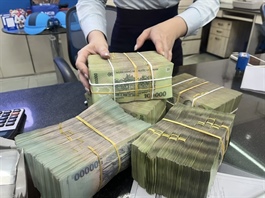Banks pressured to supply capital for public projects
Banks pressured to supply capital for public projects
Credit institutions continue to bear responsibility for providing capital to meet development demand, with a particular focus on the nation’s key public projects.
In a socioeconomic report for January, released on February 6, the General Statistics Office noted a promising start as public funding recorded positive results last month. The disbursed state capital increased by 9.6 per cent on-year to $1.4 billion, despite having five fewer working days compared to January 2024.
The government’s proposal on the supplementary socioeconomic development plan for 2025, submitted to the National Assembly on February 12, once again emphasised that public investment is a key driver to boost GDP growth. The proposal suggests raising public investment to $36 billion, up 11 per cent from the previous target and 38 per cent higher than in 2024.
“Based on our estimates, increasing the implementation rate from 85 per cent in 2024 to the government’s target of 95 per cent in 2025 could add 1.4 percentage points to Vietnam’s GDP growth next year,” said Dinh Quang Hinh, head of Macroeconomics and Market Strategy at VNDirect Securities Corporation.
With expectations of improved business conditions supporting a reduction in non-performing loans (NPLs) and fostering stable development, the banking system continues to play a crucial role as a key market maker. This is achieved through the purchase of government bonds and the attraction of medium- and long-term capital to meet state budget expenditure needs and ensure national financial stability.
According to the State Treasury’s 2025 government bond issuance plan, the total issuance volume for the year is projected to reach $20 billion. The number of market members varies across countries, typically ranging between 15 and 25, with commercial banks holding the largest share, Vietnam being no exception.
“Market makers for Vietnam’s government bond market are primarily financial institutions, mainly commercial banks, recognised by the Ministry of Finance. They play a vital role in enhancing liquidity, maintaining stability, and fostering the development of the market,” said an IMF representative.
Meanwhile, a January bond market report published by Vietcombank Securities last week indicated that yields are likely to remain stable or even rise in the following months.
“The US Federal Reserve’s interest rate cut roadmap shows a delay in 2025. As of now, the market expects the Fed to cut rates 0-2 times instead of the previously anticipated three cuts,” the report said. “Secondly, exchange rate pressure is expected to persist next month, leading to tighter interbank liquidity and maintaining interbank interest rates at a high level of around 4-4.5 per cent.
Nguyen Manh Tung, an analyst at VIS Rating, noted that the recovery of high-yield mortgage loans and the slowdown in new NPL formation in Q4 had boosted banks’ profitability and improved asset quality.
“On the other hand, the creditworthiness of some small banks remains weak due to high NPL levels and increased credit costs from retail and small business borrowers, coupled with narrowing profit margins and liquidity challenges amid intensifying deposit competition,” Tung said.
He also expressed optimism that improved business conditions in 2025 would drive a reduction in new NPL formation across the sector.
“Among state-owned banks, VietinBank saw a sharp decline in new NPL formation in H2/2024, while BIDV and Vietcombank reduced bad debts through intensified write-offs. Conversely, the asset quality of smaller banks focused on retail and smaller businesses, such as SaiGonBank and ABBank, deteriorated due to rising mortgage loan NPLs,” he said.
- 11:08 27/02/2025




























